Part 4: The End Of The Beginning
By Wes Oleszewski
It was 1755 EST time on December 14th, 1972 when the ascent propulsion system of the LEM Challenger ignited and separated from its descent stage. Mylar insulation bits and pieces were seen flying off in every direction as the rover’s camera followed the ascent stage in perfect timing. In Houston, controller Ed Fendell, who had been the person remotely controlling the rover’s camera for all of the missions that had used that system, had timed the camera’s movement with perfection. That required him to take into account the three-second delay in communications between the earth and the moon when commanding the camera to start panning up as well as the same delay in the astronauts counting down to ignition.
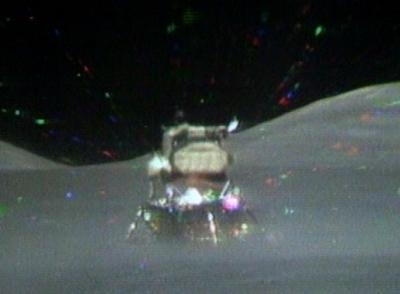
On Apollo 15 the camera had a malfunctioning clutch and thus could not pan up to watch that mission’s ascent from the lunar surface. On Apollo 16 the camera was still able to pan up, but the rover had been parked about 65 feet closer to than LEM than planned. Fendell’s camera was unable to tilt up fast enough to keep up with the ascent stage which was soon out from view. On Apollo 17, we saw the ascent stage rise gracefully into the blackness of the lunar sky and then pitch-over. At pitch-over you could look right into the nozzle of the ascent engine which glowed blue-white. There was no flame because there was no atmosphere and the hypergolic propellants used in the LEMs engines burn clear. Still, the sight was amazing as the ascent half of the Challenger sped out of view. The rover’s camera then panned down and scanned what for three days had been an active scientific work site, but now had suddenly become noting more than artifacts left behind.
Some two hours after lunar liftoff, the Challenger rendezvoused with the CSM America. Now, the networks managed to break in and cover the event live. That of course meant that the American public would miss the first seven minutes of “The Mod Squad,” “The Waltons” and “The Flip Wilson Show.” How would our culture survive such a blow? After some station-keeping and photographic exercises the two modules lined up for docking. Command Module Pilot Ron Evans gracefully eased his vehicle in for a soft-dock. The three latched on the probe, however, did not catch. “Okay, we didn’t get it,” he reported as Cernan echoed the report. Indeed the two vehicles needed to back off slightly and try again. The second time was the charm as the latches caught and then as Evans hit the retract switch, the nitrogen bottles fired and the two vehicles were brought together for a hard dock. No sooner had the crew announced a hard-dock than Mission Control called up and
stated that President Nixon had a statement that he wanted read up to the crew. Capcom Gordon Fullerton dutifully read it to the crew:
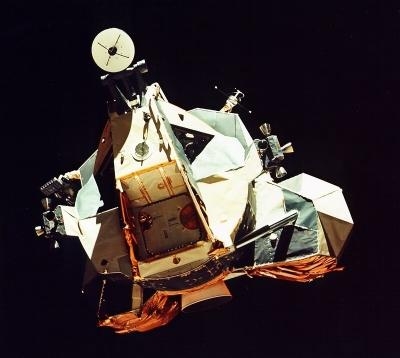
"As the Challenger leaves the surface of the Moon, we are conscious not of what we leave behind, but of what lies before us. The dreams that draw humanity forward seem always to be redeemed, if we believe in them strongly enough and pursue them with diligence and courage. Once we stood mystified by the stars; today we reach up to them. We do this not only because it is man's destiny to dream the impossible, and to do the impossible; but also because, in space, as on Earth, there are new answers and new opportunities for the improvement of and the enlargement of human existence. This may be the last time in this century that men will walk on the Moon, but space exploration will continue, the benefits of space exploration will continue, and there will be new dreams to pursue, based upon what we have learned. So let us not mistake the significance or miss the majesty of what we have witnessed. Few events have ever marked so clearly the passage of history from one epoch to another. If we understand this
about the last flight of Apollo, then truly we shall have touched a 'many splendored thing'. To Gene Cernan, Jack Schmitt, and Ron Evans, we say God speed you safely back to this good Earth."
Sitting at home I was sickened. “It was those guys in Washington who were ending Apollo. If Nixon thought it was so great, why didn’t he do something to keep it going?” I thought. It would not be until years later that I would discover that the early end of Apollo had Nixon’s fingerprints all over it. Apparently, I was not the only one upset by that disingenuous message. NASA’s Apollo Lunar Surface Journal captured the moment aboard Apollo 17 itself and says:
“Gene made a gracious statement of thanks and then Jack and Ron added brief thanks of their own. But, inside, Jack was steaming. Apollo was ending, but there were still 27 years left in the century and he hated the thought of an American President telling a whole generation that they would have no chance to do their own lunar exploration. But there was nothing Jack could do but suppress his anger and, in the meantime, there was some more exploration that he and the others could do before they headed home.”
Four and a half hours later the Challenger was jettisoned and America with her crew remained alone in lunar orbit.
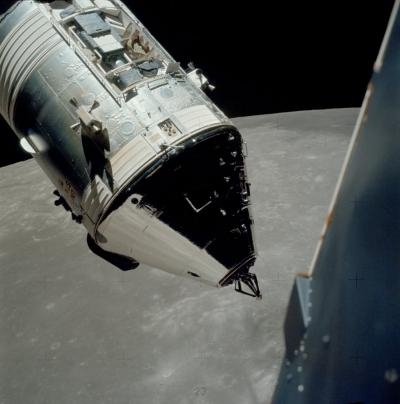
Ron Evans, who had remained aboard the CSM “America,” was almost completely overlooked by the media. Yet he had a very important and complex job to do while orbiting the lunar surface. He was dedicated to managing and operating the Scientific Instrument Module, also known as the “SIM Bay.” Loaded with an Infrared Scanning Radiometer, a Far-Ultraviolet Spectrometer, a Lunar Sounder Optical Recorder, a Mapping Camera, a LASER Altimeter and a Gama Ray Spectrometer, the SIM Bay kept Evans well occupied. Now, he had the other two crewmembers to lend a hand.
On Saturday, December 16, 1973 Apollo 17’s CSM fired its Service Propulsion System engine and burned out of lunar orbit; America the spacecraft and America the nation withdrew from the moon.
On Monday afternoon, Ron Evans opened the Command Module’s hatch and went out into the void between the earth and the moon. Hand-over-hand he made his way aft to the SIM Bay. His objective was to retrieve film canisters and he made ventured along, describing his every move over the intercom. Cernan came on at one point with a stoic tone saying, “Keep talkin’ Ron, I’m walking this one with ya’.” He was likely having memories of his own spacewalk on Gemini IX which he often describes as being, “The spacewalk from hell.” Over some two hours and 10 minutes, Cernan exhausted himself and came close to death. Evans, however, was having a blast outside; laughing and even waving at the TV camera as he worked. His EVA went without a hitch, of course we in the general public had to wait and see it as a highlight on the evening news a few hours later.
Reentry took place on Wednesday afternoon December 19th. This was my last “Apollo day off from school” and for the first time during the mission the TV coverage was pretty extensive. That was good for me because the lightweight coverage of the rest of the mission had left me with about a half hour of audio tape to fill. There was an interesting “first” that happened during Apollo 17’s reentry. For the first time NASA PAO allowed us to all hear what the astronauts were actually saying inside the spacecraft, in real time, during the reentry and recovery phase. Apparently they allowed the crew to go on open mic. VOX. The only time that they could not be heard was during the black-out portion of the reentry. As soon as the black-out cleared, however we could hear them again. I was entranced! It was so cool to hear them talking to each other and making calls, that I did not even care that I did not know what most of it meant. I would figure it out later when I played the tapes
over and over driving my family insane.
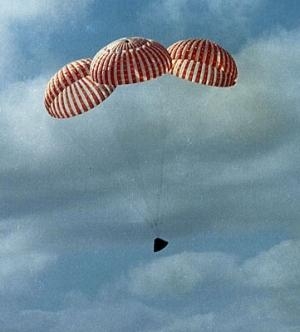
Splashdown was a work of art and the impact of the spacecraft was captured up-close by the TV camera. Later we saw close-up pictures of the crew exiting the vehicle and flopping into life-rafts. The images were so good that you could see Schmitt scoop a hand full of the blue Pacific and toss it gleefully at Evans. In short order the crew were on the deck of the carrier Ticonderoga making short speeches. I considered Cernan’s statement about Apollo 17 being the end of the beginning. It rang hollow, even to a 15-year-old; Apollo 17 was over, and so was Apollo.
Spool the clock ahead 40 years. While writing this piece I glanced over my shoulder and saw my five-year-old daughter in “the play area” of our home rooting through a basket of assorted and well-worn toys. Coincidentally, she came up with an old, partly broken Saturn V toy and raising it over her head was making the “Shhhhoooommm” sound. “Where ya’ goin’ sweetie?” I asked, expecting an answer about some cartoon show fairy land. Unexpectedly she replied, “To the moon.” Without hesitation I dropped my work and turned to her, “You wanna go to the moon eh? Well daddy can help.” With that I dug into my collection of space stuff and soon we had a LEM and a couple of astronaut action figures from the “Daddy Shelf.” A bit of dusting off and we were down on the carpet playing lunar EVA. Soon daddy said, “Do you wanna see real men walking on the moon?” “Yeah.” She replied with a wide smile. I broke out my
Spacecraft Films Apollo 17 DVD set and put EVA number one on the big TV. As they worked the ALSEP she asked, “What they were doing?” I told her that they were setting up experiments. “We need some experiments,” she said with a glow. Thus we gathered old pen tops, toy thimbles, doll chairs and even a packing peanut with a toothpick stuck in it- they all turned into experiments. “Ya’ know what else we need?” she asked, “It starts with an “R”… rover.” Daddy got one of those from his collection too. For the entire afternoon we played being on the moon. At one point she asked innocently “Are those guys on the moon right now?” I replied “no” and explained that all of that took place long ago when daddy was a little boy and that we don’t go to the moon anymore. Busying her tiny fingers with our “experiments” in our ALSEP on the carpet, she asked, “Why?”
Indeed, “why?”
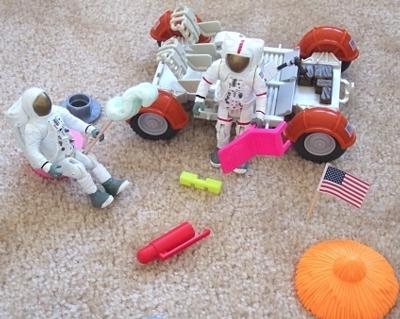
How does one answer that to a five-year-old? How does one who had the privilege to watch men walking on the lunar surface, live, in real time, explain to the next generation why it is that we as a nation simply gave it up? How does one explain to our children that they will quite likely not have the chance go and do such things themselves or for that matter even have the chance to see it happen, live? How does one explain the myth that the money spent on Apollo would be used to cure all of the ills here on earth if we would just stop going to the moon? How does one explain to a kid what myopic, self-serving politicians are? How does one explain to future generations that my generation stepped away from the peaceful advancement of human civilization because the TV rating were low? Perhaps we should use the words of President Obama and simply, arrogantly state that we no longer go to the moon, nor will we ever again go to the moon because “…to put it bluntly, Buzz has already been
there.”
Indeed, “why?” will be the next generation’s question and my generation has no good answer.
 ANN's Daily Aero-Linx (04.16.24)
ANN's Daily Aero-Linx (04.16.24) Aero-News: Quote of the Day (04.16.24)
Aero-News: Quote of the Day (04.16.24) Airborne 04.10.24: SnF24!, A50 Heritage Reveal, HeliCycle!, Montaer MC-01
Airborne 04.10.24: SnF24!, A50 Heritage Reveal, HeliCycle!, Montaer MC-01 Airborne 04.12.24: SnF24!, G100UL Is Here, Holy Micro, Plane Tags
Airborne 04.12.24: SnF24!, G100UL Is Here, Holy Micro, Plane Tags Airborne-Flight Training 04.17.24: Feds Need Controllers, Spirit Delay, Redbird
Airborne-Flight Training 04.17.24: Feds Need Controllers, Spirit Delay, Redbird







